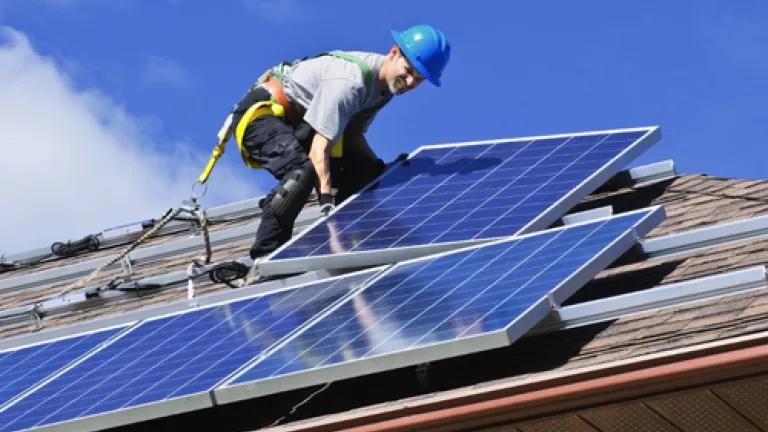
When I put up solar panels on my house several years ago, the process was, if I may speak plainly, a royal pain. In the end, it was worth it to be able to generate my own, pollution-free energy, but every step seemed designed to make my life more difficult. Even after the system was installed and paid for, I still had to wait months, for more inspections, new meters, and other painful delays, before I could officially turn it on.
If we want to get solar energy into more homes and business across the country, the process needs to be more efficient. In addition to being a headache for homeowners and solar contractors, procedural inefficiencies actually increase the price of solar power. While the cost of solar hardware—panels and such—has come down 80 percent in recent years, Americans, on average, pay nearly twice as much for solar energy as they do in Germany. Much of this price difference is due to “soft” costs, including the inefficient, expensive permitting process.
But change is afoot. Last month, New York launched a simplified solar permit that can be adopted anywhere in the state, and momentum is building across the country to bring down the cost and hassle of solar permitting, making it easier, and as much as $600 cheaper, to install solar power in your home.
(image courtesy Green MPs, via Flickr)
For contractors, the permitting process makes it difficult to do business. Big solar contractors employ a team of people just to research and fill out permit applications, as well as “permit runners,” whose full-time job is to bring stacks of paperwork to multiple permitting authorities, stand in lines, and pay fees. Solar contractors also pay big up-front costs to buy equipment, which ties up much of their available credit. While they wait weeks or even months to install that equipment, their business is essentially paralyzed. It’s a waste of time and money, and it can keep smaller contractors, and their potential customers, out of the game.
In New York, a group of solar contractors, most of whom couldn’t afford to employ “expeditors” for their paperwork, approached the county government for a solution.
“There are 113 different municipalities in Long Island,” explains Sail van Nostrand, the owner of Energy by Choice, and former head of the Long Island Solar Energy Industries Association. “So there were 113 different ideas about what the requirements for a solar permit should be. We never knew how many sets of drawings were required, or even what had to be in them. Some of them required surveys, which don’t even show the roof! The fees were astronomical. The paperwork was a nightmare. ”
The association worked with the county government and the Long Island Power Authority to establish unified standards for solar permitting, which nine out of ten towns in Suffolk county—the vast majority of Long Island’s solar market--have since adopted. That standardized form served as the model for New York State’s newly minted Unified Solar Permit, a simple online form that any of the state’s 1,600-plus cities, towns, and villages can adopt for residential solar installations. The streamlined permit recommends, among other things, a single fee, a single inspection, and a decision within 14 days.
Vermont has taken things a step further by eliminating the need for a permit altogether. If you want to put in a small-scale residential solar installation in Vermont, you fill out a one-page registration form. That’s it. No fees, no permit. The registration process takes only ten days, allowing customers to get their systems up and running quickly, and freeing up capital for contractors so their businesses can keep rolling. Though the state doesn’t have much by way of rebates, tax breaks, or other solar incentives, it’s not going to kill you with paperwork. And that little efficiency makes a big difference for consumers and contractors.
“We arguably have the lowest soft costs in the country,” says Andrew Savage of All Earth Renewables, in Williston, Vermont.
Making solar permitting more efficient across the country could help bring down the cost of solar energy nationwide. At SolarPermit.org, some 800 permitting authorities, covering 90 percent of the solar market, are posting their permitting requirements, making it easier for contractors to figure out what paperwork they need.
Our friends at Vote Solar, together with the Interstate Renewable Energy Council, have developed a set of 9 best practices for solar permitting that can bring down the cost of permitting by as much as 60 percent—as much as $600 per home. At their new website, Project Permit, you can find out how easy it is to get a solar permit where you live—and if it’s not, they give you the resources you need to get the ball rolling.
We need to make clean energy an easy option for homes and business. Eliminating wasteful red tape by creating a sensible, unified permitting process will make it simpler, and less expensive, for homeowners and businesses to use solar power. The more solar power we produce, the more energy dollars stay in our communities; the more good, local jobs we create (although perhaps not for permit runners); and the faster we speed the transition to a cleaner, more efficient energy system that reduces pollution and helps stabilize the climate.
This post is part of NRDC’s Wasteland series, featuring people, towns, businesses and industries that are finding innovative ways to cut waste, boost efficiency and save money, time and valuable resources.
